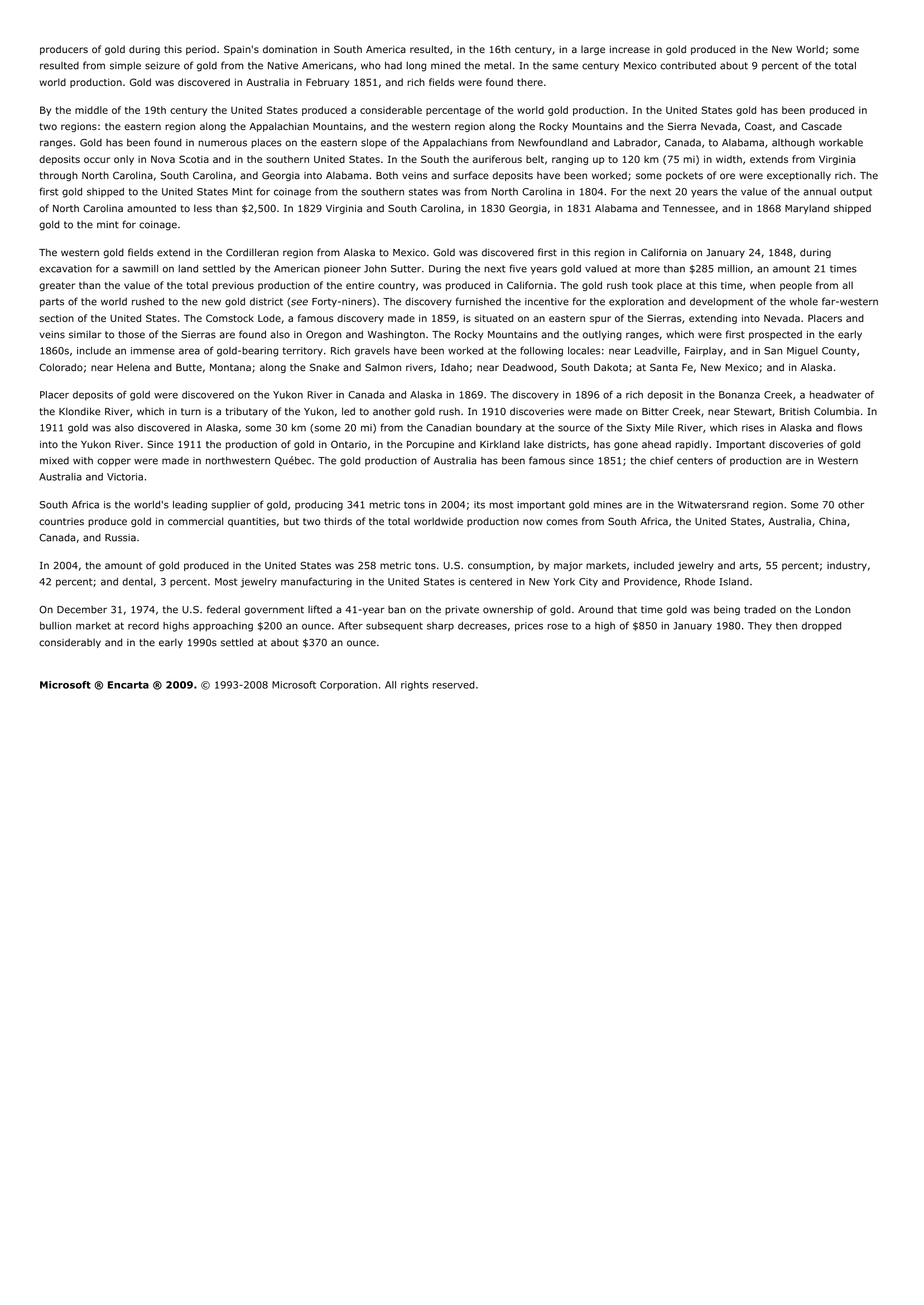Gold - chemistry.
Publié le 11/05/2013
Extrait du document
«
producers of gold during this period.
Spain's domination in South America resulted, in the 16th century, in a large increase in gold produced in the New World; someresulted from simple seizure of gold from the Native Americans, who had long mined the metal.
In the same century Mexico contributed about 9 percent of the totalworld production.
Gold was discovered in Australia in February 1851, and rich fields were found there.
By the middle of the 19th century the United States produced a considerable percentage of the world gold production.
In the United States gold has been produced intwo regions: the eastern region along the Appalachian Mountains, and the western region along the Rocky Mountains and the Sierra Nevada, Coast, and Cascaderanges.
Gold has been found in numerous places on the eastern slope of the Appalachians from Newfoundland and Labrador, Canada, to Alabama, although workabledeposits occur only in Nova Scotia and in the southern United States.
In the South the auriferous belt, ranging up to 120 km (75 mi) in width, extends from Virginiathrough North Carolina, South Carolina, and Georgia into Alabama.
Both veins and surface deposits have been worked; some pockets of ore were exceptionally rich.
Thefirst gold shipped to the United States Mint for coinage from the southern states was from North Carolina in 1804.
For the next 20 years the value of the annual outputof North Carolina amounted to less than $2,500.
In 1829 Virginia and South Carolina, in 1830 Georgia, in 1831 Alabama and Tennessee, and in 1868 Maryland shippedgold to the mint for coinage.
The western gold fields extend in the Cordilleran region from Alaska to Mexico.
Gold was discovered first in this region in California on January 24, 1848, duringexcavation for a sawmill on land settled by the American pioneer John Sutter.
During the next five years gold valued at more than $285 million, an amount 21 timesgreater than the value of the total previous production of the entire country, was produced in California.
The gold rush took place at this time, when people from allparts of the world rushed to the new gold district ( see Forty-niners).
The discovery furnished the incentive for the exploration and development of the whole far-western section of the United States.
The Comstock Lode, a famous discovery made in 1859, is situated on an eastern spur of the Sierras, extending into Nevada.
Placers andveins similar to those of the Sierras are found also in Oregon and Washington.
The Rocky Mountains and the outlying ranges, which were first prospected in the early1860s, include an immense area of gold-bearing territory.
Rich gravels have been worked at the following locales: near Leadville, Fairplay, and in San Miguel County,Colorado; near Helena and Butte, Montana; along the Snake and Salmon rivers, Idaho; near Deadwood, South Dakota; at Santa Fe, New Mexico; and in Alaska.
Placer deposits of gold were discovered on the Yukon River in Canada and Alaska in 1869.
The discovery in 1896 of a rich deposit in the Bonanza Creek, a headwater ofthe Klondike River, which in turn is a tributary of the Yukon, led to another gold rush.
In 1910 discoveries were made on Bitter Creek, near Stewart, British Columbia.
In1911 gold was also discovered in Alaska, some 30 km (some 20 mi) from the Canadian boundary at the source of the Sixty Mile River, which rises in Alaska and flowsinto the Yukon River.
Since 1911 the production of gold in Ontario, in the Porcupine and Kirkland lake districts, has gone ahead rapidly.
Important discoveries of goldmixed with copper were made in northwestern Québec.
The gold production of Australia has been famous since 1851; the chief centers of production are in WesternAustralia and Victoria.
South Africa is the world's leading supplier of gold, producing 341 metric tons in 2004; its most important gold mines are in the Witwatersrand region.
Some 70 othercountries produce gold in commercial quantities, but two thirds of the total worldwide production now comes from South Africa, the United States, Australia, China,Canada, and Russia.
In 2004, the amount of gold produced in the United States was 258 metric tons.
U.S.
consumption, by major markets, included jewelry and arts, 55 percent; industry,42 percent; and dental, 3 percent.
Most jewelry manufacturing in the United States is centered in New York City and Providence, Rhode Island.
On December 31, 1974, the U.S.
federal government lifted a 41-year ban on the private ownership of gold.
Around that time gold was being traded on the Londonbullion market at record highs approaching $200 an ounce.
After subsequent sharp decreases, prices rose to a high of $850 in January 1980.
They then droppedconsiderably and in the early 1990s settled at about $370 an ounce.
Microsoft ® Encarta ® 2009. © 1993-2008 Microsoft Corporation.
All rights reserved..
»
↓↓↓ APERÇU DU DOCUMENT ↓↓↓
Liens utiles
- « Life is a self-replicating, evoluing system based on organic chemistry » Qu’est ce qui est vivant ?
- Gold Exchange Standard (économie).
- Women's Diving: Olympic Gold Medalists.
- Women's Individual Gymnastics: Olympic Gold Medalists.
- Women's Track and Field Relay: Olympic Gold Medalists.

































